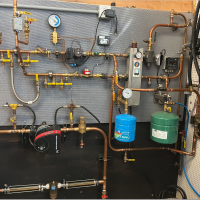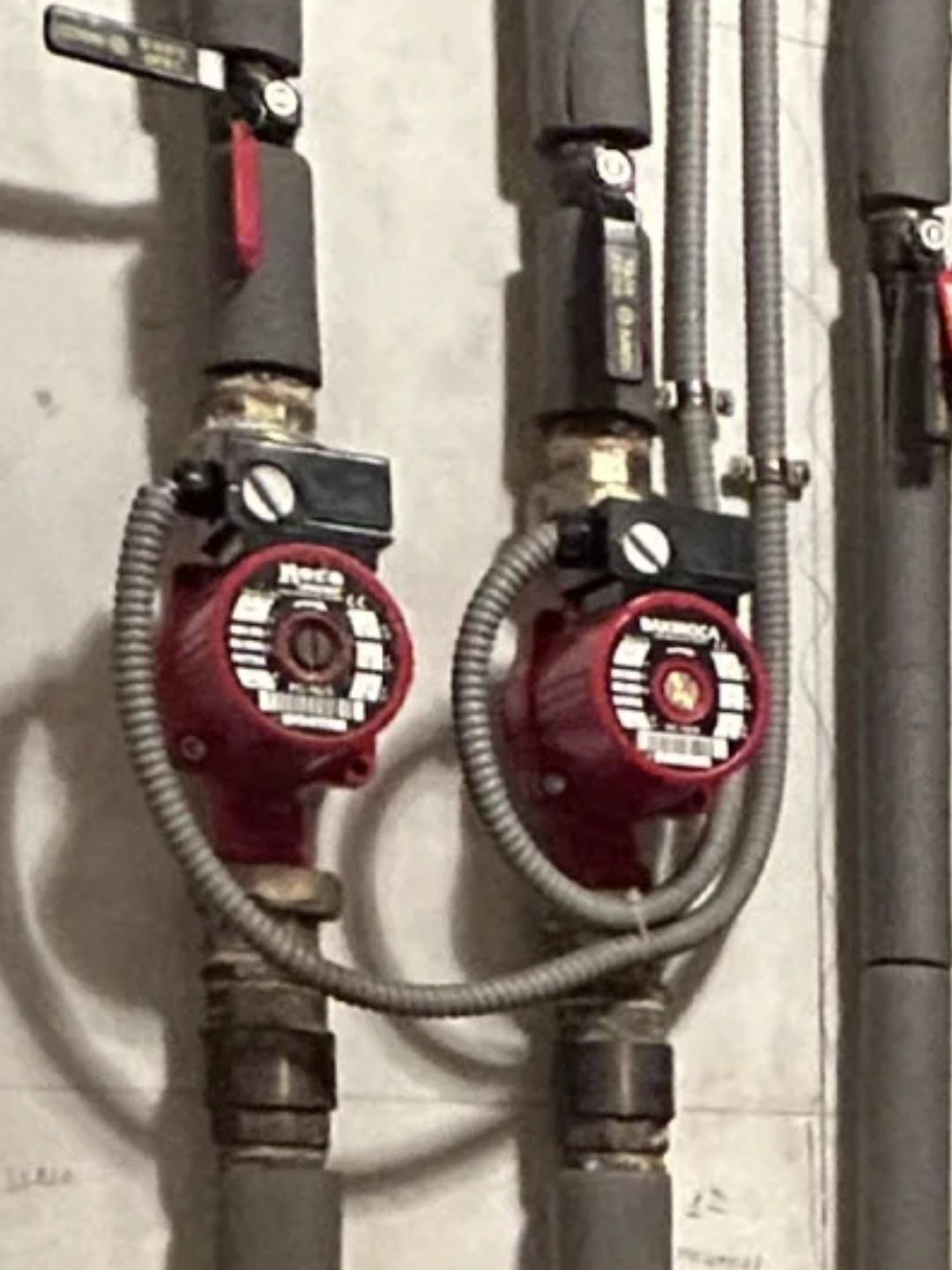Radiators getting hot when heating circuit off
Hi all, I've recently moved to a new house with an oil boiler. It does hot water and heating. Model is Fer G3G K130.
The unit itself seems to work ok, except I'm getting an strange issue. The boiler is in summer mode, but even so, some of the radiators (on the top floor) are hot, even with the thermostat set to zero.
I've attached a photo of the internals - you can see the top pump is for the heating, and bottom goes to the hot water tank. There doesn't appear to be any valve to stop the flow of hot water into the heating loop which seems a bit strange to me.
Is it possible that heat to pushing to flow in the heating loop, even without the pumps running, so that the radiators are getting hot. Seems to me like an inefficient setup!
Comments
-
Exactly what is happening. In fact, that is a rather odd setup. Which direction are those pumps pumping?
Br. Jamie, osb
Building superintendent/caretaker, 7200 sq. ft. historic house museum with dependencies in New England0 -
the bottom pump goes to the hot water tank inside the unit, the top pump goes to the heating circuit.
When I opened the unit, the top pump was unplugged, presumably because there are 3 pumps on the pipe work outside of the unit which are activated by the thermostats on each floor.
the oil boiler is on summer mode, and all the pumps are switched off, yet still when the boiler is on for the hot water, one of the radiators on the top floor gets hot!0 -
I think we need a complete diagram of the way that is all plumbed…
In the meantime, if there are no valves I suspect you are seeing gravity flow in the radiators. How to fix the problem, though… depends on how things are actually hooked together.
Br. Jamie, osb
Building superintendent/caretaker, 7200 sq. ft. historic house museum with dependencies in New England1 -
Odd piping on that boiler with those two circs?. If the two pumps are ever running in series, double the head.
A Wilo Star 16 for example is 16' head, (about 7 psi) so two in series could be pushing open the zone valve a bit. Looks like they are set at different speeds on the red knob?
I think that HW has around an 8 psi shut off, depending on the model.
Bob "hot rod" Rohr
trainer for Caleffi NA
Living the hydronic dream0 -
Can you show the 3 pumps outside the unit? One of those pumps serves the top floor. All 3 pumps should be wired to a zone panel (maybe?). You're not in the States, and its all 230 volt power, so is there a way for you to verify the pump is actually powered and running, or is the boiler water just gravitating through the top floor loop. Check the return pipe for the top floor as well. It could be gravitating backwards. It's likely the internal check valve in the pump, or external flow check is faulty if the pump isn't running.
0 -
I’ll upload a pic later. Stupid question, do these pumps need to be powered to stop flow through them (even if they are not running)?
0 -
Here you go. Let me try and explain the setup from left to right:
- Pump which provides basement floor heating
- Heating return for middle floor
- Pump outbound for middle floor
- Pump outbound for top floor
- Heating return for top floor
- Pump on hot water circuit (not sure this one is needed, doesn't seem to do anything!)
- Hot water return
- Cold water to house
- Cold water into house
Another data point from today. I had the middle and top floor manual valves closed overnight and left the bottom floor open. No hot water flowed into the heating circuit with this setup.
Then this morning, I turned the boiler off and opened the valve to the top floor. Again, the electricity supply to the pumps is switched off so now pumps are activated. After an hour, I came to check the outbound pipe to the top floor and it was warm, so I'm guessing the hot water in the hot water tank is flowing backwards and into the heating circuit, but only seems to do it when the valve to the top floor is open.
0 -
See if those pumps have internal checks. Wilo pumps, like in the boiler, put them in the flange. Those pumps have union connections, so its easy enough to check.
Or maybe those fittings below the pumps are spring check valves.
0 -
You're right, the valve below it appears to be an Arco one way valve. But to me, it still doesn't explain why water is rising through this upstairs circuit when all the pumps and the boiler are turned off. The only way I can see it happening in the system is if the hot water flows back out of the hot water tank (in the oil boiler) and up into the heating circuit (as seen in the first pic). But then I'm not sure this is possible as it looks like there is a one-way valve below the pump leading to the hot water tank…
Also, should I plug in the top pump in the oil boiler (leading to the heating circuit). It was unplugged when I opened the cover, and I assume this is because there are 3 separate pumps outside of the boiler.?
0 -
Generally the checks are on the discharge of the circulators.
If those are checks on the inlet, could be something stuck inside holding it open.
Are there service valves before the circs to open those checks?
Bob "hot rod" Rohr
trainer for Caleffi NA
Living the hydronic dream0 -
it looks like there are checks on the supply and return so my guess would be one or more is stuck open or maybe even rotted away.
0 -
Hot water will rise .., The hot water from the boiler is rising up to the top floor radiator ,it is called Heat Migration . The higher the rise the more it wants to flow…. Looks like a spring check just below the wall circulator . It should hold back on the heat migration when the circulator shuts off . If there is only a mild migration, you can shut one of the valves to that zone for the summer . To fix I would add a second to the return ..
Hope this helps
What part of Europe do you live ?
There was an error rendering this rich post.
0 -
Thanks all for the advice - I'm in Madrid, Spain but am British, so I'm not used to how they do things here! No service valves before the circulators, so a bit of a painful task to replace for my level of skill (ie - zero)!
0 -
Usually, when I hear this complaint, there is an absence of, or a malfunctioning, flow-control valve.
0 -
on further inspection, I have an Arco spring valve on both the flow and the return for all the zonal loops. Am I right in thinking that if the pump is not turned on, water should not be flowing through these loops? It would be pretty bad luck if both have failed…I'm seriously confused!
0 -
-
Well, there shouldn't be — but a pump won't stop flow when it's off. So you need the checks.
Br. Jamie, osb
Building superintendent/caretaker, 7200 sq. ft. historic house museum with dependencies in New England0
Categories
- All Categories
- 87.3K THE MAIN WALL
- 3.2K A-C, Heat Pumps & Refrigeration
- 61 Biomass
- 427 Carbon Monoxide Awareness
- 119 Chimneys & Flues
- 2.1K Domestic Hot Water
- 5.8K Gas Heating
- 114 Geothermal
- 165 Indoor-Air Quality
- 3.7K Oil Heating
- 76 Pipe Deterioration
- 1K Plumbing
- 6.5K Radiant Heating
- 395 Solar
- 15.6K Strictly Steam
- 3.4K Thermostats and Controls
- 56 Water Quality
- 51 Industry Classes
- 50 Job Opportunities
- 18 Recall Announcements






